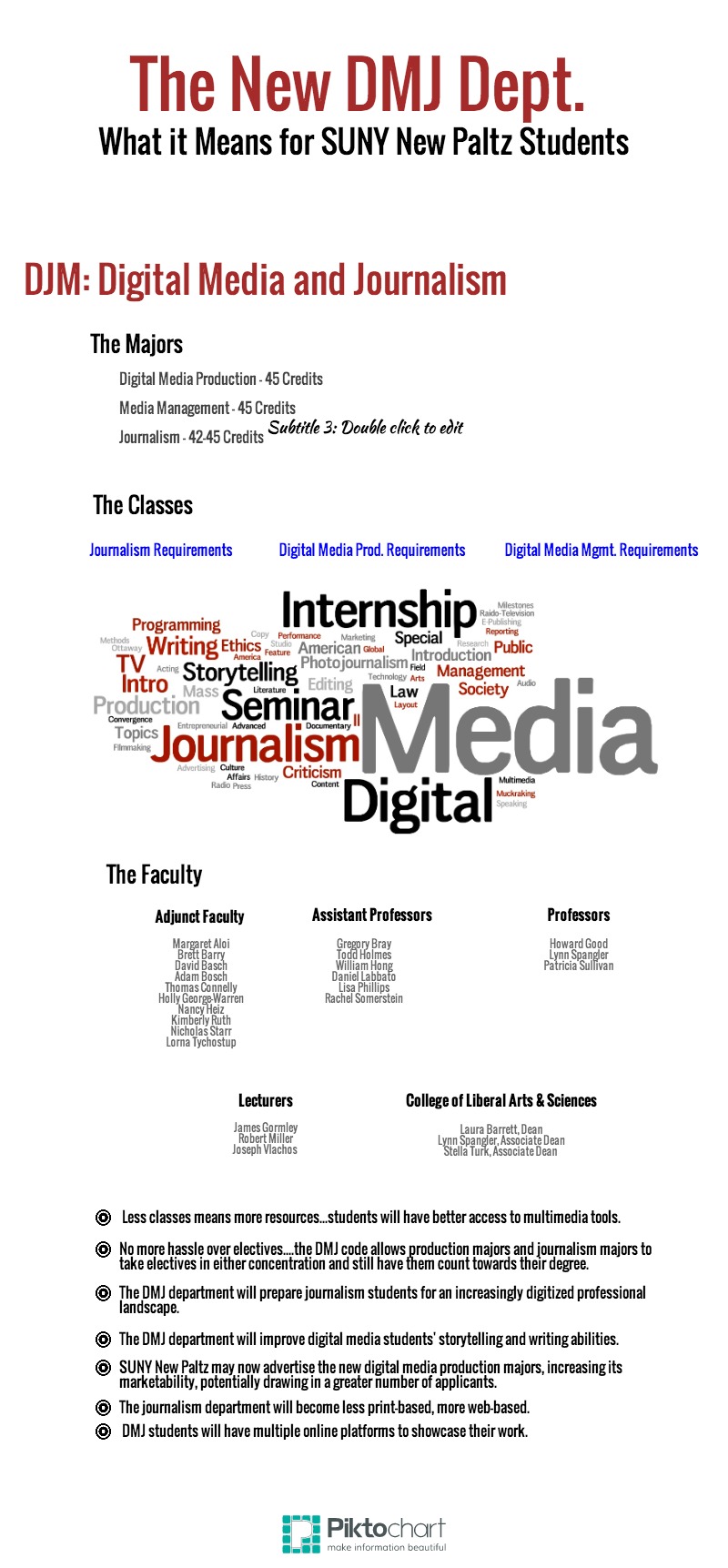The journalism program at SUNY New Paltz has never had its own department.
This year, however, it’s secured its own spot in the new Digital Media and Journalism department (DMJ), and with it, journalism and digital media students may find new opportunities.
There are three majors in the new department: digital media production, digital media management, and journalism. By putting those three majors in their own department, Lynn Spangler, Associate Dean of the College of Liberal Arts and Sciences said, students will have a more efficient learning experience.
“It’s a great thing,” Spangler said. “The Chair doesn’t have to divide resources into six different areas. Now, it’s three, and it’s not really dividing because they can all use those same resources.”
This switch has been years in the making. Spangler along with Howard Good, a journalism professor, and a number of other faculty members, have been designing the change for dozens of years.
“I came in ’83 and he came in ’85…so we’ve been around a long time and we’ve seen the different versions of this department, but I’m very excited,” she said. “It’s something that 20 years we had hoped for but for one reason or another didn’t happen,” she said.
Before the growth of the programs in their own right, the three majors were all found under a single massive department: Communication and Media.
“They said, ‘Okay, we’re going to merge you with radio and television.’,” Good said. “Radio and television was a major…in what was the Communications and Communications Disorders department. But at the last minute, due to budget issues, they threw us together not just with [radio and television] but also with…communication disorders. The result was that there was a lot of potential for…lack of identity, lack of collegiality,” Good said.
“We have hundreds of majors in the three different areas,” Spangler said. “So we have a lot of majors. It kind of makes sense since we’ve grown so big that we should split so we can focus on different areas.”
Professor Gregory Bray, who teaches a number of digital media production courses, graduated from the old SUNY New Paltz Communications and Media department in 2000.
“There was no major in media production,” Bray said. “So, for somebody like me, who was very interested in having a production experience, it was a very good program, but, at the same time, I thought there could be some improvements.”
As a professor, he is in a position to finally make those improvements.
“When I came back as a teacher, we took a look at the program and we realized that there were some things we need to address,” Bray said. Some of those things included the “unnecessary” focus on radio in the Radio and Television program, the inability to advertise a major in media production, and divvying up the massive Communications and Media department.
“The division of the departments for DMJ and CMM is really one that was based in numbers…based on undergrad student population, we had the largest undergraduate population at SUNY New Paltz. That’s awesome…it’s like ‘Yay, we’re the most popular kid in school, man!’ But at the same time it’s completely untenable,” he said.
The switch to DMJ also allowed students to avoid problems with whether or not an elective they took would count towards their major.
“Students would sometimes take electives that had a CMM extension. If they come in here, we can make sure that it counts as an elective for their major, and vice versa,” Bray said.
The department was formed not only to increase academic efficiency and the program’s marketability, but also to offer a curriculum to students that will better prepare them for the working world beyond SUNY New Paltz.
“A lot of content, a lot of work that students wind up doing in their careers after graduation…is through the World Wide Web,” Bray said. “So there are a lot of streaming opportunities, more video jobs, than ever before.”
Good agreed that the new department addresses the increasingly digitized new cycle.
“Students live and are going to work in a digital world, and we thought we’d get synergy by combining…the contemporary version of radio and television with the contemporary version of journalism,” he said.
